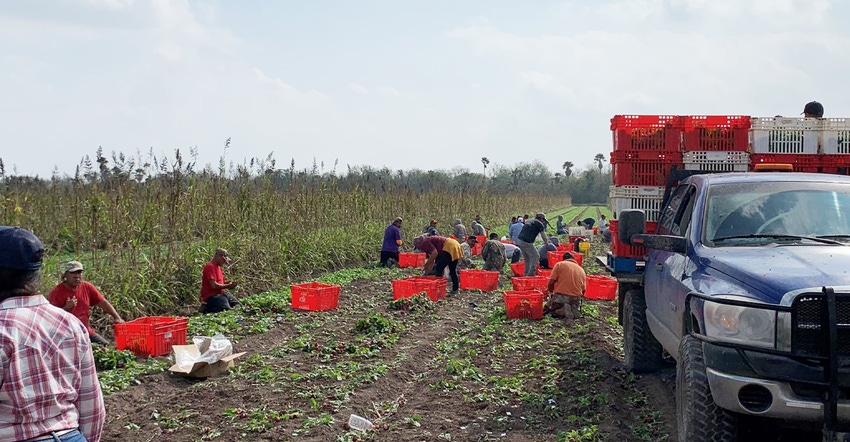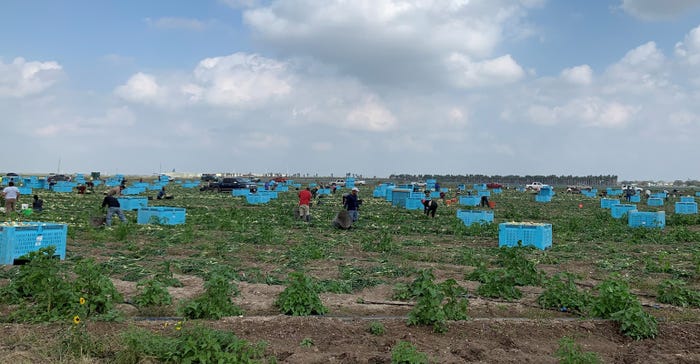
Farmers in the Texas Lower Rio Grande Valley are thankful for available moisture and are patiently waiting for temperatures to warm and fields to dry before beginning spring planting.
“We have good moisture, perfect moisture,” says Abraham Castillo, a Valley cabbage, onion, cotton, corn, and milo grower. “Every year, we have to pre-water to plant,” Castillo says. “This year, we have more than enough moisture. As soon as the soil dries and the cold weather disappears, we will plant, probably in two weeks.”
That is the case across the region, says Texas A&M AgriLife Extension IPM Specialist Danielle Sekula.
“Farmers are ready to go, just holding off, waiting for cold weather to blow through."
Conditions are supposed to improve this week, she says, including a warm-up Friday and a chance of rain Monday and Tuesday. '"If it dries up, we will be planting.”
She adds that moisture is good across the region. “It’s too sticky now to plant. No one has started planting grain sorghum or corn yet. But they are all ready to go.”
Cabbage and onions
Castillo is finishing cabbage harvest and just starting with onions. “We are low on water, so we only planted few onions.”
 Onion harvest is underway in South Texas. Cotton and grain farmers are waiting for warmer temperatures to begin planting. (Photo by Kurt D. Thelen, Michigan State University)
Onion harvest is underway in South Texas. Cotton and grain farmers are waiting for warmer temperatures to begin planting. (Photo by Kurt D. Thelen, Michigan State University)
Following a down market last year, he expects prices for his yellow onions to be better but still has to contend with competition from Mexico. “By the time we harvest in late March or April, Mexico’s onions will be in the market. We just never know about the market and weather. We can’t control either one.”
He says the cabbage market has been good. “Price went down early but now is picking up.”
He likes the cotton market. “I’ll maintain my usual cotton acreage or go a little higher. Cotton price is great.”
Castillo typically runs about equal acreage for cotton, corn, and milo. “I might plant a little more corn because of price.”
Sorghum acreage will not be down much. “We started dry last year, so a lot of sorghum went in behind failed cotton. This year, we have good moisture to start.”
He says corn and milo ground go into vegetables in the fall.
Sekula says area cotton farmers in the Willacy area are also ready to plant, “just waiting for the cold to pass.”
She anticipates corn acreage to be up a bit with grain sorghum about the same as last year.
Insects
Sekula cautions producers to be watchful for thrips in cotton. “I’m concerned with thrips early and chili thrips around July. We had hardly any pests last year in cotton because of the winter freeze, but this year we have a lot of moisture, a lot of weed hosts and we are not sure what pests they harbored. “We will have to see how heavy early thrips pressure is and watch chili thrips in early July.
“I’m also concerned about sugarcane aphids. I recommend growers pick grain sorghum varieties with sugarcane aphid tolerance.
“We have a lot of sugarcane aphids everywhere. Volunteer sorghum, Johnson grass, and haygrazer planted for windbreaks all have sugarcane aphids. They usually migrate in from Mexico, but they are already here.”
She says growers have done a good job of cleaning up volunteer sorghum, but with Johnsongrass and other hosts, heavy populations could develop early, around booting stage, early April to mid-May. “I’m curious about what populations we will see.”
She recommends seed treatments and tolerant varieties. “Once we get to harvest, we’re in more of a hurry up and get it out before the next peak. I expect the first peak as early as mid-April or as late as mid-May.”
Sekula said late-planted sorghum had heavy sugarcane aphid infestations last year. “The freeze killed some sorghum and some growers replanted.”
A combination of heat, humidity, a late crop, and rain-delayed harvest set the stage for aphid buildup. “We started out with small populations of aphids then populations reproduced easily, and growers were not able to spray, so they had heavier populations from late June to August.”
A few fields of fall-seeded sorghum experienced heavy infestations, Sekula says.
“Now, we have plenty of sugarcane aphids harboring everywhere. We expect to see in the field how well the tolerant varieties hold on.”
Moisture concerns in season
Castillo says pest infestations are not his biggest issue. “Our main concern is moisture; we need to get timely rains. I farm in two water districts, and both are out of water, so we will depend mostly on rain. I have bought some water rights and can pump some out of the river, but irrigation will be tough. I also have two wells I can pump, but it’s expensive to do.”
He adds that everything will be expensive this year. “Chemicals, fertilizer, seed — everything is up. Yields have to be exceptional,” he says, to make any profit. “It takes more acres now to make a little profit, a very little profit.”
Sekula says expenses are up across the board. “Fertilizer has more than doubled.”
Cutting costs is not an option, Castillo says. “About the only thing we can do is soil test more and put out what the crop needs — not over or under.
“Cutting down will mean not making yield. We have to apply what it needs.”
Castillo is thankful that boll weevils pose no threat to his cotton crop. “Boll weevils used to be terrible; we had to spray every three days. Now, the Boll Weevil Eradication Program is helping. The weevil is almost gone. Back in the ‘70s and ‘80s, we were happy to make two bales; now we’re making three and more. The boll weevil was a disaster.”
Castillo has been farming since 1973, “as soon as I got out of high school.” The family started farming in the area back in the 1950s.
For more information about LRGV pest issues, check Sekula’s South Texas IPM Audio Updates.
About the Author(s)
You May Also Like






